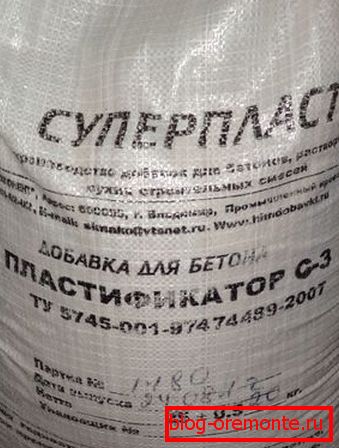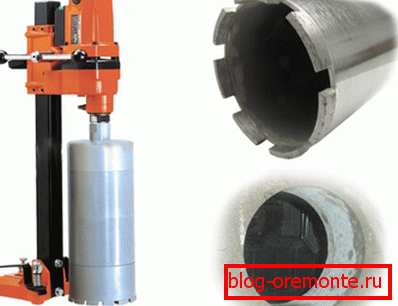Plasticizers for concrete and other modifying additives
What is plasticizer for in concrete? Can I prepare a plasticizer for concrete with my own hands? What other modifying additives can be used in the preparation of concrete mixture? Let's figure it out.

What it is
What is a plasticizer for concrete?
Let's start with a small lyrical digression.
The mechanism of concrete setting and strength gain is related to the chemical process of cement hydration. The minerals that form it, reacting with water and atmospheric carbon dioxide, create a solid crystalline structure. It binds the filler - sand and / or rubble.
Curiously: porous materials are often used as filler - expanded clay, perlite, etc. Their use allows you to improve the insulating properties of the resulting monolith.
Cementing milk, when water is bound by chemical reactions and evaporates, turns into a cement stone, which has a slightly smaller volume. As a result, between the grains of the filler are formed the very pores, reducing the final strength.

Their number can be reduced by increasing the mobility of the concrete: grains of sand and rubble sliding relative to each other under their own weight will coil as closely as possible. In addition, in this case, the concrete mix will become more fluid and fill the formwork with minimal effort.
How can I increase the mobility of the mixture?
- Making it more liquid. Alas, not an option: the strength of the monolith will not increase, but decrease. Unbound water during evaporation will leave in it a large number of the very voids that we are trying to get rid of.
- Increasing the amount of cement. It perfectly performs the function of a kind of lubricant for the filler; however, the cement during the hydration, as we recall, shrinks, so that the efficiency of the method will be slightly lower than expected. Costs will increase significantly.
- Adding to the mixture a substance that improves the sliding of the filler grains relative to each other.. Actually, it is this class of additives called plasticizers.
crazy hands
So, the plasticizer is called a special additive that improves slip. Knowing the properties of this additive, it is more than simple to guess how to replace a plasticizer for concrete:
| Addition | Using |
| Liquid soap, shampoo | It is introduced by mixing the mixture in the amount of 200 ml per bag of cement. |
| Washing powder | Another excellent plasticizer replacement for concrete. It is added in the amount of 100 - 150 g per 50 kg of cement. Pre-completely dissolved in warm water. |
| Slaked lime | Известь-пушенка добавляется в сухую смесь в количестве не более 20% от массы цемента. Slaked lime, помимо увеличения подвижности, придает бетону бактерицидные свойства, предотвращает появление грибка. |
| PVA glue | Addition 200 граммов ПВА на ведро раствора увеличит его подвижность, повысит прочность и водостойкость. |

Super hyper
Recently, along with the usual plasticizing additives on the market you can often find the so-called superplasticizer for concrete. Does it have any real advantages? Or is this just another marketer ploy?

Special features
They come down to a combination of several functions in one supplement. For example, a frost-resistant plasticizer for concrete increases its mobility and at the same time makes it possible to hydrate cement at negative temperatures, which makes it possible to pour a monolithic structure in winter.
Most superplasticizers have a certain set of functions common to all compositions. Let's explore the benefits that the most likely C - 3 plasticizer for concrete will offer at our disposal.
| Function | Description |
| Cement savings | To produce concrete with the same compressive strength, approximately 15% less cement is needed. The amount of water required for mixing the mixture is also reduced - by 30 - 35%. |
| Increased mobility | The workability of the mixture with the addition of C-3 corresponds to the brand P5, which allows you to fill it with narrow forms with tight reinforcement. In addition, there is no need for vibropacking. |
| Increase strength | With the addition of superplasticizer to the mixture with a fixed ratio of sand and cement, the final strength is increased by 25%. The effect is achieved due to the notorious reduction in the number of pores. |
| Increase frost resistance | It is achieved again by reducing pores. Water does not penetrate into the thickness of concrete and does not crystallize there when the temperature drops, expanding and causing damage to the structure of the monolith. |
| Reduced shrinkage | Since the filler is initially distributed in a form with a maximum density, with cement hydration, a decrease in its volume has almost no effect on the linear dimensions of the structure. |
| Slowdown setting | This property of C-3 is useful in cases where the concrete to be transported in a mixer. If, on the contrary, the fastest possible set of strength is required, an additional additive is introduced into the mixture, a hardening accelerator. |
Любопытно: встречающиеся в продаже гиперпластификаторы для бетона - это всю те же пластифицирующие добавки с дополнительной функциональностью. Приставка «гипер» лишь означает, что в состав пластификатора для бетона входят не меламиновые, а более эффективные поликарбоксилатные полимеры.
Prices
We give the current wholesale prices for some materials.
- A kilogram of dry C-3 costs 48 rubles.

- The same superplasticizer, but already in solution, is sold at 20 rubles / liter.
- A liter of liquid MPlus is already sold for 50 rubles.
- The price of a liter of M5Plus hyperplasticizer is as much as 85 rubles. However, the high cost is fully compensated by low consumption: if for C-3 it is 0.4 - 0.7 kg / 100 kg of cement, for MPlus - 1 liter / 100 kg, then for M5Plus consumption is 200 ml / 100 kg It is easy to calculate which plasticizer is best for concrete in terms of minimizing costs.
Application
The only subtlety in the use of plasticizers is that they should not be added to the finished concrete, but to the water for mixing the mixture. What is the reason for the instruction? Yes, simply with the fact that otherwise it is extremely difficult to achieve a uniform distribution of the plasticizer.
Other supplements
What other modifiers can be used to change the properties of the concrete mix?
- Curing accelerators. They are used to compensate for the slow setting due to the addition of a plasticizer. In addition, there is often a need for accelerated setting of the mixture under specific conditions of concreting.
The most obvious example is the concreting of the pool bowl in the combined formwork for the bottom and walls: too slowly hardening concrete in the vertical formwork will partially squeeze the already flooded bottom.

- Curing retarders. They are needed, as we have mentioned, primarily when transporting the mixture over long distances.
- Antifreeze additives. They allow you to pour formwork that does not have high thermal insulation properties at low temperatures.
Useful: the formwork, as a rule, is removed before the set of full brand strength by winter concrete. At this stage, the processing of the monolith (anchoring of metal structures, drilling of technological holes, etc.) is possible, but without shock loads. Diamond drilling of holes in concrete, like cutting of reinforced concrete with diamond circles, does not create microcracks in the structure of the monolith and makes the edges of the hole or cut extremely smooth.

- Air entraining additives. At the cost of reducing the strength of concrete, they make it more frost-resistant: the resulting closed cells in the cement stone serve as a space that allows water to expand during crystallization without harming the monolith.
Conclusion
We will consider our acquaintance with the class of materials used in concreting to be successful. As usual, the video in this article will offer the reader additional information. Successes!